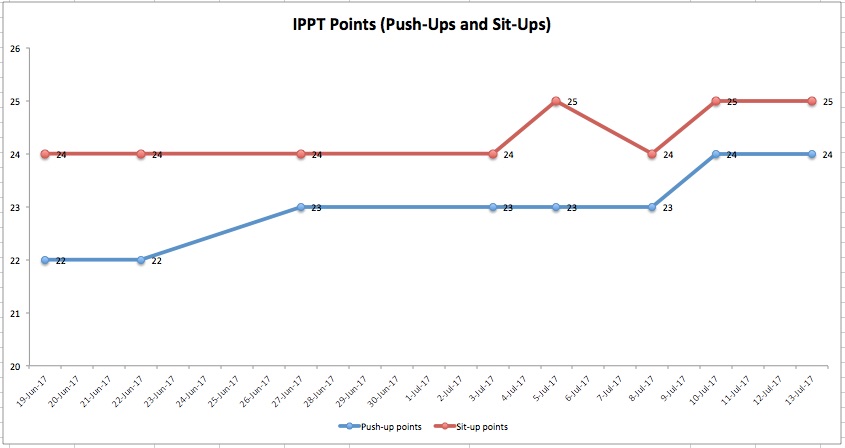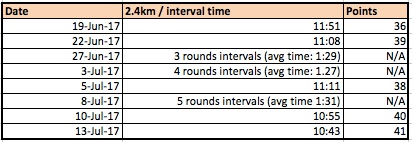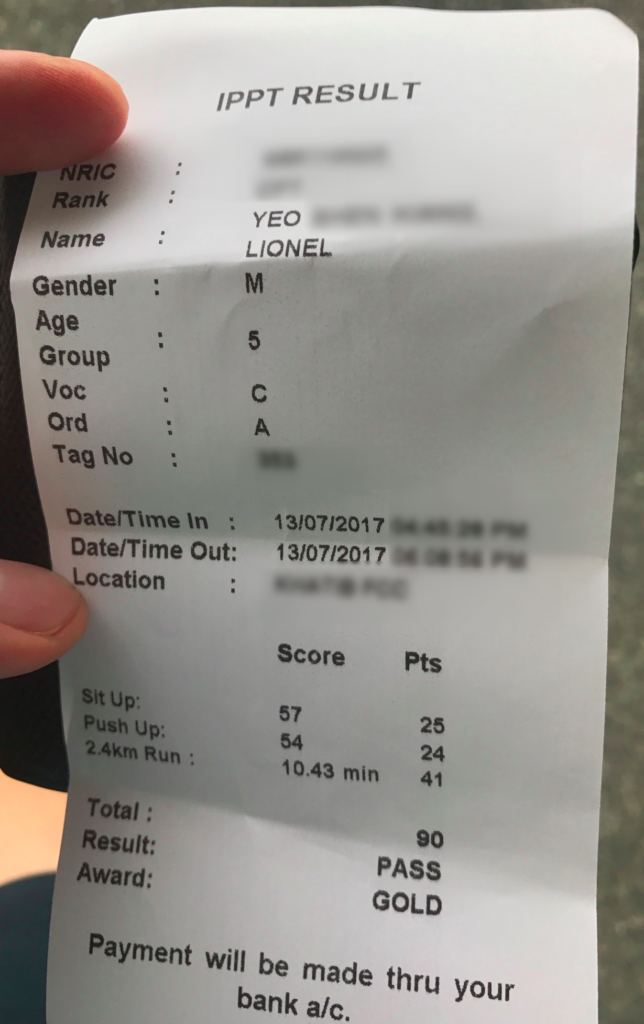 One of the biggest complaints about my blog is that I don’t write enough about “personal finance stuff”. Well whoops, because here’s yet another non-money blogpost to annoy you with.
One of the biggest complaints about my blog is that I don’t write enough about “personal finance stuff”. Well whoops, because here’s yet another non-money blogpost to annoy you with.
7 months ago, I wrote The Ultimate Guide To Achieving An IPPT Gold. It went on to become one of my most searched-for posts, because hey, IPPT continues to be the thorn in the side for hundreds of thousands for suffering male Singaporeans everywhere.
The message in that post was simple: 1) Train hard, 2) Track your performance, and with enough time, you’ll get your IPPT Gold.
However, one of the biggest annoyances for me was the time factor. It took me 12 weeks of REALLY hard training, twice a week, before I managed to achieve that coveted Commando IPPT Gold (90 points and above). I managed to do it, but it was a loooooong journey.
So it got me thinking – would I be able to get those same results in under a month?
Tim Ferriss often advocates focusing on high-leverage activities to get the maximum results for the least amount of effort. Could I apply that same principle to achieve a Commando IPPT Gold – with that $500 of incentive payments that comes along with it?
Let’s find out.
Disclaimer: I’m not a doctor, consult a medical professional before you begin any training regime, yadda-yadda. You’re a smart person – you don’t need a disclaimer to tell you not to blindly follow stuff you read online, right?
Step 1: Light The Fire
Deadlines are some of the best motivators. To guarantee that I didn’t fall off the training wagon, I booked my IPPT appointment when I was still terribly, terribly unprepared.
This was a HUGE psychological hurdle – I don’t normally commit to something unless I’m sure I can kill it. But in this case, the concrete deadline served as an excellent motivator. No matter what, I had a looming IPPT test ahead, so I might as well make the best of it.
I also knew that I could retake the test as many times as I like so it was essentially a low-stakes situation. At the worst case, I’d have wasted a couple of hours but at least I’d have gotten another training session in.
7 months after last year’s IPPT, my fitness levels had atrophied back to baseline. On my first training session on 19 June 2017, I hit 82 points (out of 100). That would have given me a Silver, and it was also my same starting point before I started my 12-week training program last year.
In order to get a Commando Gold, I’d have to improve by another 8 points within a month. They say that if your goals don’t make you worried, you’re not setting them high enough, amirite?
Step 2: Focus On High-Leverage Activities
For last year’s test, I followed Goody Feed’s IPPT training guide. But if I wanted to speed things up, I had to focus exclusively on the stuff that would give me the biggest growth in the shortest period of time. This meant 3 things:
Additional push-ups (even in bad form):
I read that your biggest strength gains comes not from your first few reps, but when you’re struggling like a baby to complete your last few. (I don’t know if this is actually true, but it seemed to make sense)
So after I completed my 1-minute of timed push ups, I’d push myself to do as many additional ones as humanly possible. When I couldn’t do anymore proper push ups, I sacrificed on form – I’d wriggle my butt, only push up my upper body, etc – anything to eke out those last few drops of strength.
That might be frowned upon at the gym, but I knew that I had to completely tear down my muscles (without injuring them) if I wanted bigger gains in my next session.
Flat-out interval training:
Point-wise, the 2.4km run is the highest ROI way to spend your time. Every 10 seconds you cut down gives you an additional point, which is easier to do than say, 4 additional push ups.
Practice 2.4km runs aren’t the best way to see dramatic improvements. Instead, High Intensity Interval Training (HIIT) helps you to rapidly improve your stamina, so I focused on that instead. For my intervals, I ran flat out for 400m, with 60-second rest periods in between.
Rather than gunning for 6 intervals from the start and doing a meh job for each, I started with just 3 rounds running at top speed (we’re talking hyperventilating-about-to-puke-kind of top speed), and gradually added a round with each session.
Obsessive tracking:
Just like last year, I tracked my progress obsessively. While my progress for each individual station went up and down, the goal was to make sure my total points were constantly improving. Here’s a chart of my push-up and sit-up points:
Here’s my 2.4km run progress:
By tracking, I could quickly identify my weak areas and target to improve them.
For example, by 5th Jul I was hitting 23/25 points for push-ups, and 25/25 for sit-ups, but not great timing for 2.4km. That made me realise that I needed to focus more on my 2.4km training for the final week before the test.
Step 3: Use Psychology On The Test Day
Test day came, and by then I had reached 89 points during my trial training runs – just 1 point short of what I needed for a Commando Gold.
Push ups and sit ups
Sit ups were no problem, but the push-up station was way stricter this time: They now have 1 PTI watching each person, probably because of the many cheating cases in the past. It’s now impossible to get away with a substandard push up (they gave me 1-2 no-counts towards the end), but thankfully I managed to hit 24 points.
With 49 points in the bag for push ups and sit ups, I now had to achieve a time of 10:50 and below for my 2.4km run to get a Gold. Since I had hit 10:55 during my last training session, I was counting on the adrenaline and the competition to help me close that remaining 5-second gap.
The 2.4km run – disaster strikes
Once the run started, I took off with a good start. But I’d made a serious error – in my excitement to get started, I failed to do a proper warm-up. This became apparent 200m into the first round, when my calves started cramping up. It wasn’t painful enough to stop, but it kept coming back every 10 seconds or so. To make matters worse, I also felt an semi-urgent need to poop.
Now, in a normal training session, I would have stopped, called it a day, and run to the toilet. But since I’d already “wasted” 1.5 hours at the IPPT centre, I said “Screw it – I’m going to walk away with at least a Silver to make my time here worthwhile.”
This is a psychological phenomenon known as the sunk cost fallacy. It’s usually a negative thing, but we can also use it to our advantage. In this case, I used it to push myself to continue running even though I felt like giving up.
When I hit the 3rd round at 5 mins 20 seconds, a funny thing happened – I realised I actually had a chance at Gold. All I had to do was keep up the same pace for the next 3 rounds. However, anyone who’s taken 2.4km before knows that the 4th and 5th rounds are usually the toughest. You’re usually exhausted by then, and you’re trying to conserve energy before that last burst of energy for the final round.
But with the Gold and an extra $200 as a mental motivator, I focused on overtaking just one person at a time. This is where IPPT works in our favour – because everyone starts at different times, there’s usually a steady stream of runners all around the track by the 4th round. That allowed me to focus on just overtaking the person in front of me, one runner at a time.
At the last 200m, I felt like dying but I picked up the pace. I half-panted, half-sprinted towards the finish line, heard the electronic beep tagging my number, and saw my time: 10:43 – a Gold with 7 seconds to spare.
Lessons Learnt
Of course, my results aren’t a conclusive validation of this strategy. With a razor-thin margin of 7 seconds, I could have easily failed to get a Gold this time round.
Also, I wouldn’t recommend this as a sustainable training strategy. Compressing huge gains within a month meant that I had to push myself beyond what was probably healthy (note my wanting-to-puke feeling during interval training and completely-tear-my-muscles-down push ups). Research shows that how much you enjoy your workouts plays a huge role in whether you can stick to it for the long-term, and this definitely wasn’t enjoyable.
Still, for anyone looking to bump up to the next IPPT award level within a short time, that’s what you might have to be prepared for. There were a couple of good lessons I learnt from this experience:
- Never underestimate the power of a looming deadline. Need some motivation? A concrete deadline works way better than any productivity hack
- Find the high-leverage activities. Not all effort is created equal. Find the activities which give you the largest improvements in the least amount of time, and focus on those
- When costs are minimal, jump before you’re ready. You’ll learn a lot more by actually DOING it than preparing for it
By the way, can you think of how these lessons could be applied to investing? Smart people know how to take the lessons learnt in one domain, and apply it to another.
Now, who says that I don’t write enough about personal finance?



[…] By Lionel Yeo […]